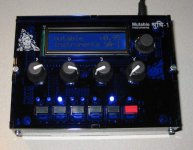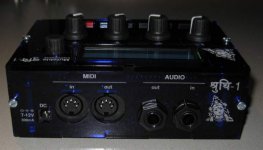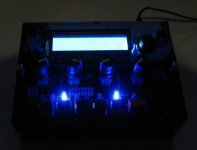Te koop Shruti-1 met SMR-4 filterboard.
Laatste firmware en custom made "Translucent Dark Blue" case.
Even mee gespeeld, maar toch niet helemaal mijn ding.
Prijs € 275,-



Meer info: http://mutable-instruments.net/shruthi1
Laatste firmware en custom made "Translucent Dark Blue" case.
Even mee gespeeld, maar toch niet helemaal mijn ding.
Prijs € 275,-



Shruthi-1 specifications
Digital/analog hybrid monosynth.
2 digital oscillators
Mixer
- band-limited sawtooth with adjustable phase
- band-limited square wave with adjustable pulse-width
- band-limited triangle wave with adjustable waveshapping
- phase-distortion emulation of a low-pass filtered sawtooth (casio CZ-101)
- phase-distortion emulation of a low-pass filtered sawtooth with high resonance (casio CZ-101)
- phase-distortion emulation of a low-pass filtered sawtooth in the Rocker Launcher’s world in which sine waves are turned into triangles (casio CZ-101)
- mysterious phase-distortion thing (could have been in the CZ-101 if the engineers at casio dared…)
- phase-distortion emulation of a Jew’s harp / Morsing (could have been in the casio CZ-101)
- stack of 4 detuned sawtooth waves (with aliasing)
- simplistic FM (1>2 configuration), with adjustable modulation index and frequency ratio
- wavetables, wavetables, wavetables!
- sweepable table of basic waveforms
- tampura transwave
- PPG harsh creature
- single cycle waveforms taken from D50 patches
- cello transwave
- slap bass transwave
- organ/drawbars single cycle waveforms
- male voice
- user wavetable, can be edited by SysEx messages
- harsh, aliasing-full waveforms obtained by bit-toggling
- sine wave with variable amount of bitcrushing
- poor man’s square with pulse-width modulation (plenty of aliasing but fat for basses)
- colored noise (sweep from low-pass filtered white noise -> white noise -> high-pass filtered white noise)
- lo-fi vowel synthesis (think “speak and spell”) with vowel morphing
Audio quality/resolution
- adjustable oscillator balance
- mixing algorithms: simple sum, simple sum with synchronization, ring modulator, xor modulator, sum with post-mixing tanh fuzz, mixing with sample rate reduction.
- extra sources: noise, sub-oscillator (triangle, square, pulse, -1 or -2 octaves) or percussive attack generator (click, glitch, blow, metallic, pop)
Filter
- Internal digital audio signal processing chain: 39216 Hz, 8 bits.
- Internal digital control signals processing chain: 980 Hz, 8 bits.
- Digital outputs: 10 MHz, 1 bit.
Modulation
- Exchangeable analog signal processing boards:
- CEM3379: based on the CEM3379, uses the same circuit as the original Shruti-1 with the “click filtering” mod
- SMR4: a 4-pole LPF (very SSM2044-like) and linear VCA built with the widely available LM13700 transconductance amplifier and TL074 op-amp
- SSM2044: SSM2044 4-pole LPF, SSM2164 2-poles HPF + linear VCA.
- IR3109: Classic Roland filter + LM13700 linear VCA.
- (à suivre)
Performance
- LFOs: 2, with square, sawtooth, triangle, sample & hold, and step sequencer shapes. Syncable to tempo. Adjustable “raise/attack” time. LFOs can be free-running, sync’ed to envelope retriggers, or retrigger envelopes.
- envelopes 2 ADSR
- modulation matrix: up to 12 source -> destination connections. Adjustable modulation amount in the -100% — 100% range
- modulation sources:
- LFO 1/2
- step sequencer
- first / second half of the step sequence
- arpeggiator gate
- mod. wheel
- aftertouch
- pitch bender
- DC offset
- CV inputs 1/2/3/4
- MIDI CC 16 to 19
- noise generator
- env 1/2
- random value resampled at each note on
- note velocity
- note number (eg for filter tracking)
- keyboard gate
- audio signal from the mixer output (decimated at 1kHz)
- operations (sum, product, max, min…) between modulation sources
- modulation destinations:
- filter cutoff
- VCA gain
- pulse width/Parameter osc. 1/2
- wide pitch osc. 1/2
- pitch, applied to osc 1 & 2 simultaneously
- very fine pitch, applied to osc 1 & 2 simultaneously
- oscillator balance
- noise level
- subosc level
- resonance
- PWM CV output 1
- PWM CV output 2
- Envelopes attack speed
- LFO1 FM
- LFO2 FM
Clock/tempo generator
Arpeggiator
- internal clock: 40-240 BPM, with some additional extra fast tempi for effects (270, 300, 360, 480, 600, 720, 960)
- external MIDI clock with divider
- 6 groove templates (swing, shuffle, push, lag, human, monkey) with adjustable amount
Sequencer
- 1-4 octave range
- up, down, up&down, random
- 15 preset rhythmic patterns + 1 programmable rhythmic pattern
- warp: creates complex rhythms by cyclical repetitions of steps (eg 1212343456567878 instead of 1234567
- latch/hold
Performance
- 16 steps, with legato/slide, velocity, and modulation
- 4 modes corresponding to different interactions between the sequence and keyboard play: latch / transpose / loop recorder / override
System and memory
- custom page in which 4 user-selectable parameters can be assigned to the 4 editing pots
- microtunings/key maps for arabic scales (1/4 tones) and a selection of hindustani ragas
- portamento, legato on/off
- master tune
Hardware and connectors
- complete MIDI implementation, including patch editing by CC or NRPNs, patch and sequencer data transfer, full memory backup, wavetable transfer. See the standard MIDI implementation chart here.
- MIDI out modes: off, thru, thru+knob movements sent as CC, sequencer/arpeggiator generated events only, polychaining, split (plays notes below split point, forwards the other notes)
- patch memory: 80 patches and 80 sequences stored in EEPROM (no backup battery required)
- firmware update by SysEx
- power: 2.1mm connector, requires 7.5V-9V 300mA supply (can be unregulated). Center pin positive (+), outer collar negative (-)
- audio input/output: 6.35 Jack (Mono audio out), 6.35 Jack (External signal in)
- cv inputs: up to 4 CV inputs for easy experimentation with controllers. Warning: only use a signal in the 0-5V range. Deeper or high peaks in the signals might damage the Shruthi-1’s ADC.
- cv outputs: up to 2 CV outputs.
- MIDI: in, out
- serial: extra UART TX pin available on control panel board (might be used in future firmware updates to control extension boards)
- ISP connector for firmware development
- controllers:
- 8 facade LEDs (current page / modulation matrix visualization)
- 6 navigation switches
- 4 pots for patch editing
- clickable rotary encoder for fine parameter adjustment or navigation
- backlit 2x16 LCD display
Meer info: http://mutable-instruments.net/shruthi1
Last edited by a moderator:

 aan een enthousiast mede forumlid
aan een enthousiast mede forumlid 